Abstract
Two groups of middle-aged men, one with and one without overt cardiovascular disease, were studied while they were taking part in a specially designed course of exercise therapy in a gymnasium. The "patients" group had at least two months pre-treatment to allow physical recovery and mental re-education before their initial very small test dose of exercise. Using short periods of progressive, mainly weight-loaded, isotonic exercises carefully regulated by control of pulse rate and avoidance of symptoms of over-exertion, both groups showed large increases in effort capacity and reductions in resting pulse rate, blood pressure and plasma lipid levels within two months. The safety of this particular form of exercise was shown in this high-risk population by the low drop-out rate and the absence of cardiovascular accidents in the gymnasium over a ten year period. It is suggested that, given suitable training of the staff and using the safeguards described, the presence of doctors and a cardiac resuscitation team is unnecessary in a gymnasium specializing in cardiac rehabilitation. This makes it possible for rehabilitation and physiotherapy departments throughout the country to carry out this effective and positive form of exercise therapy.
Full text
PDF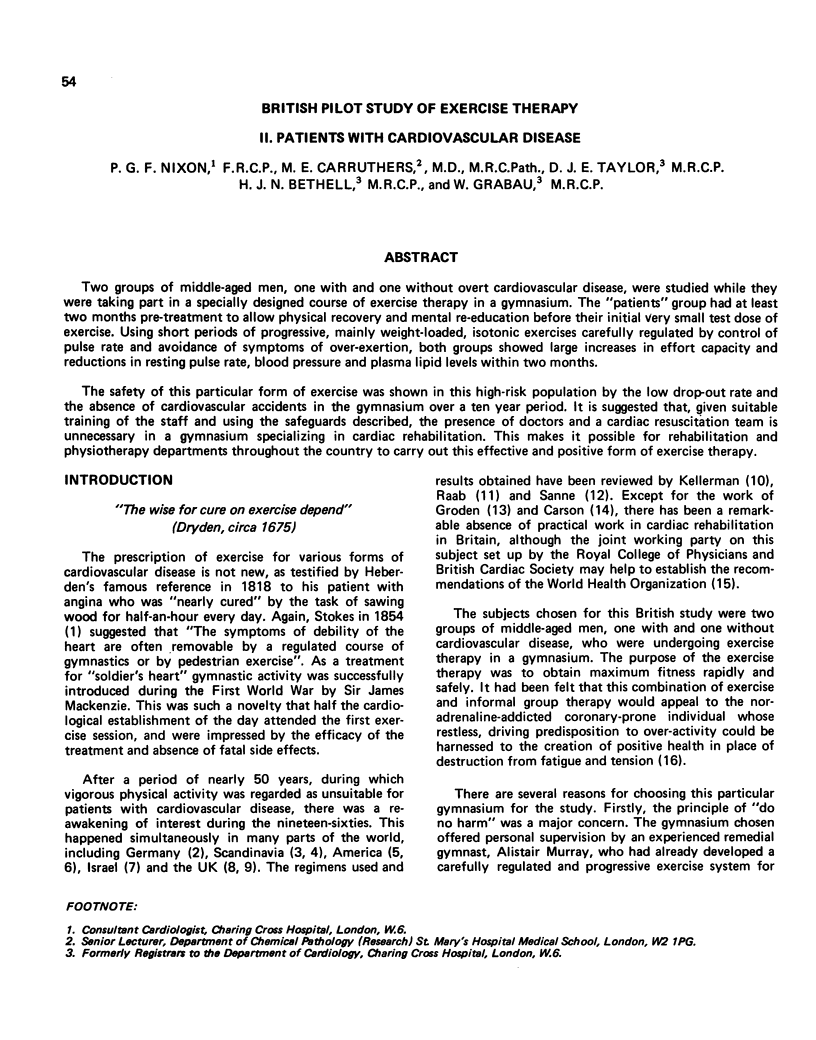
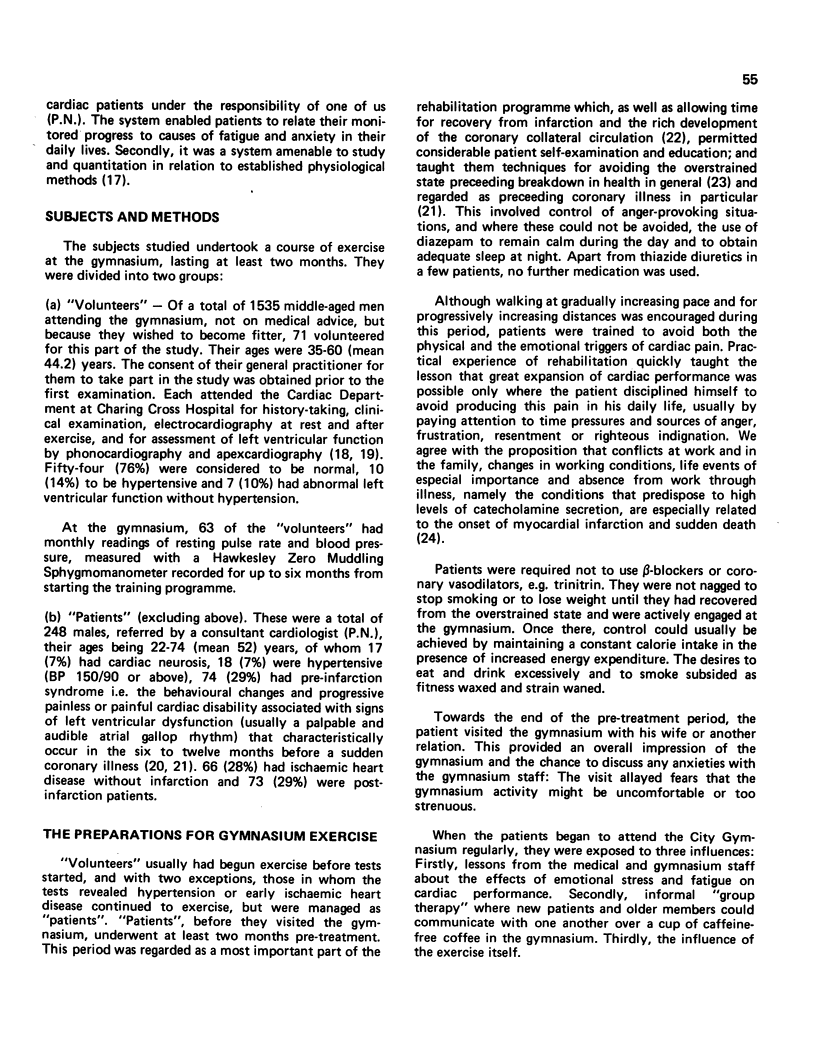

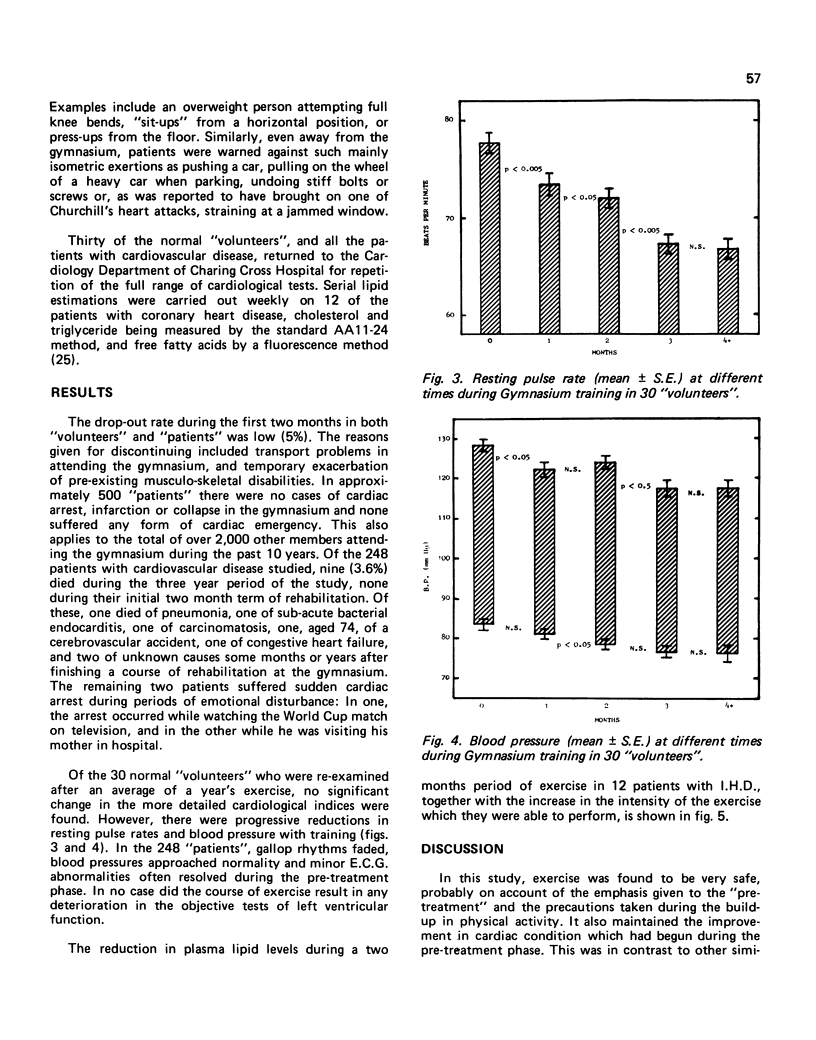
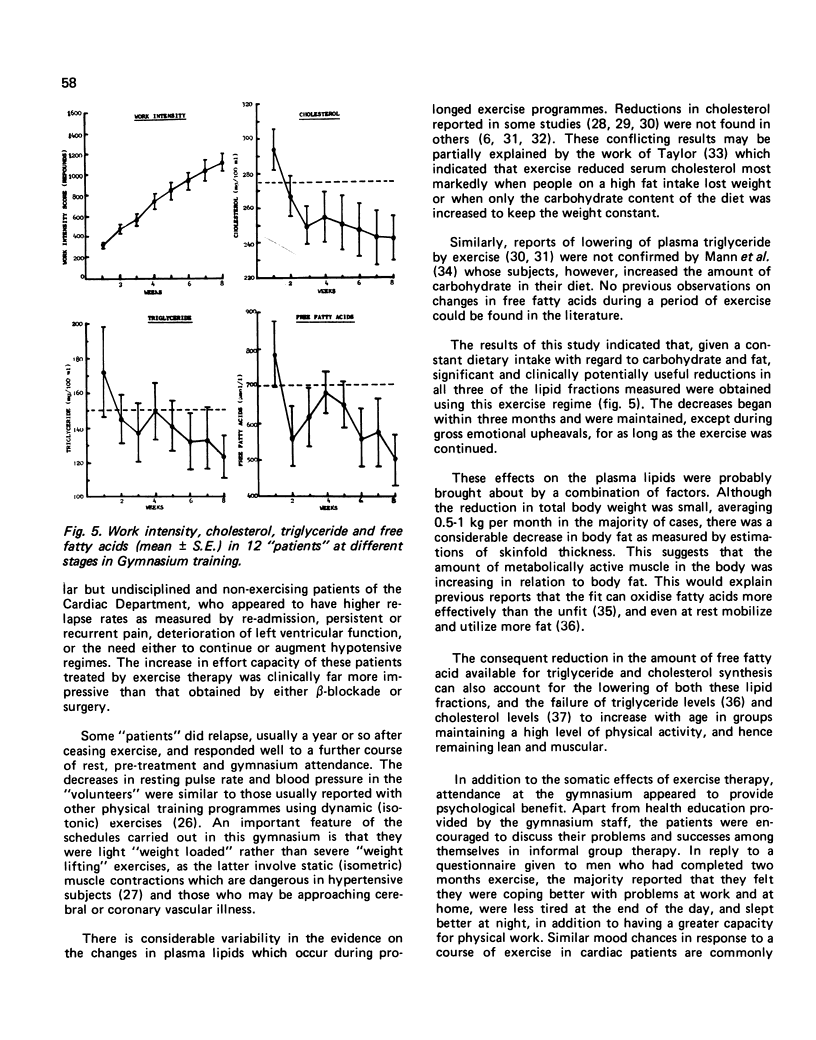
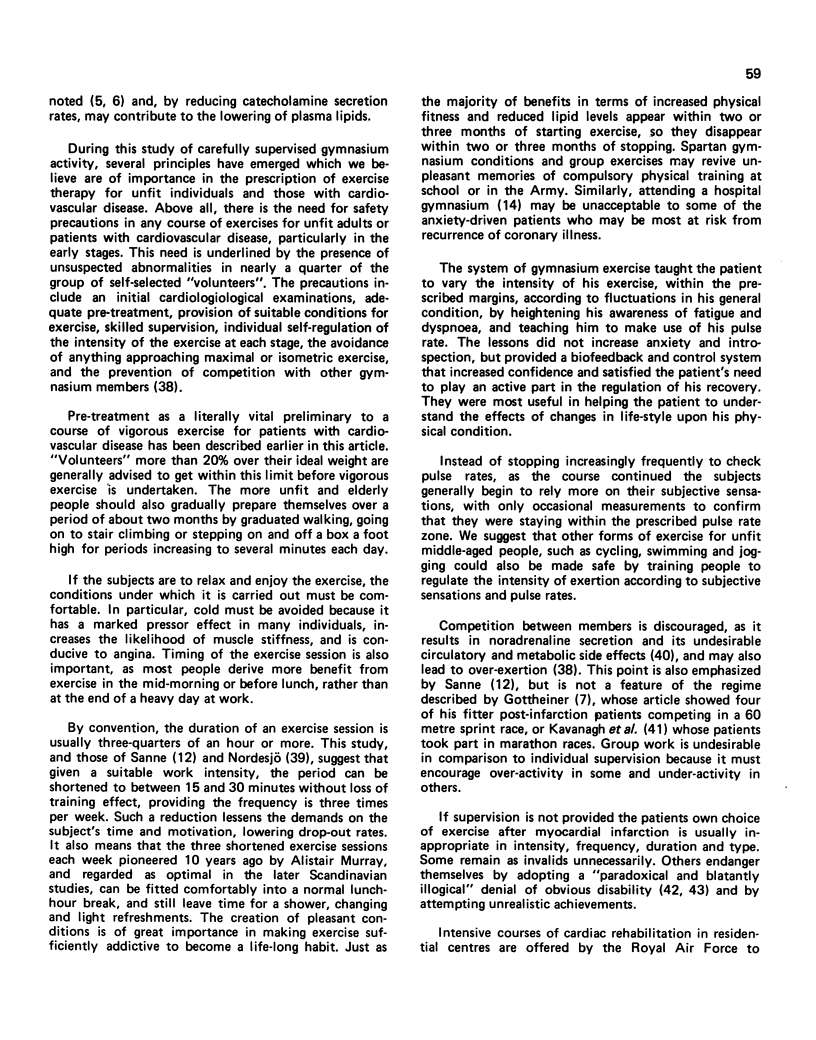
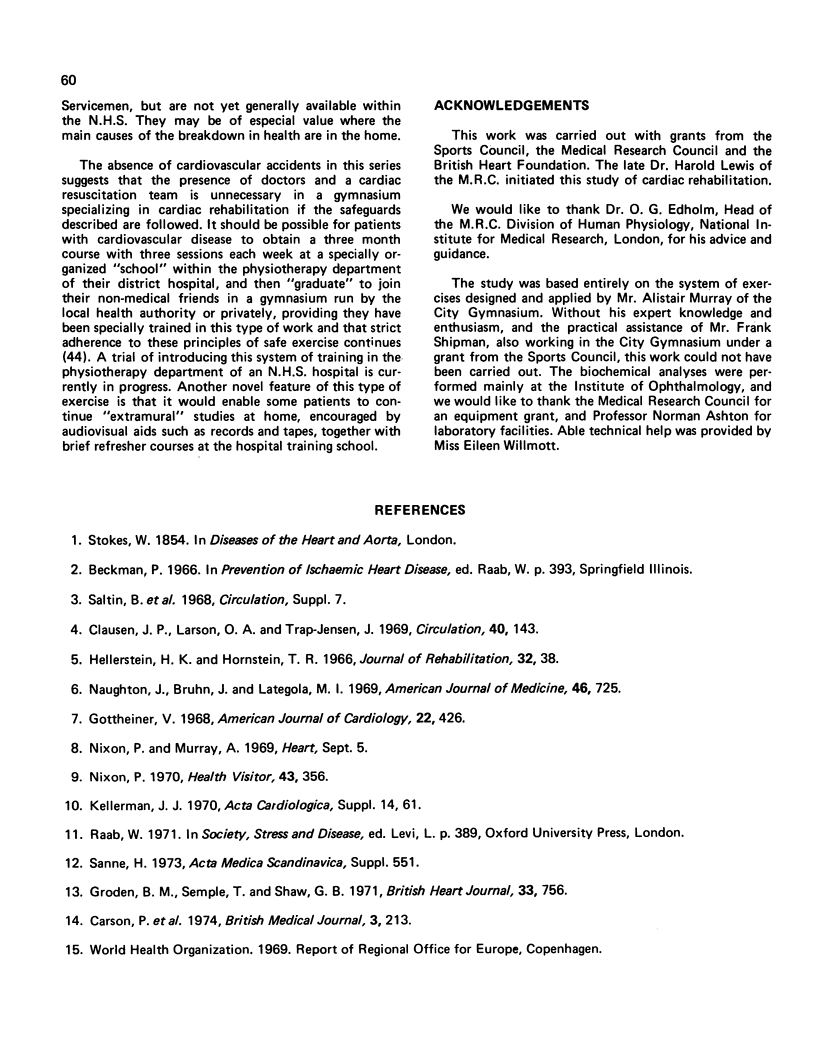
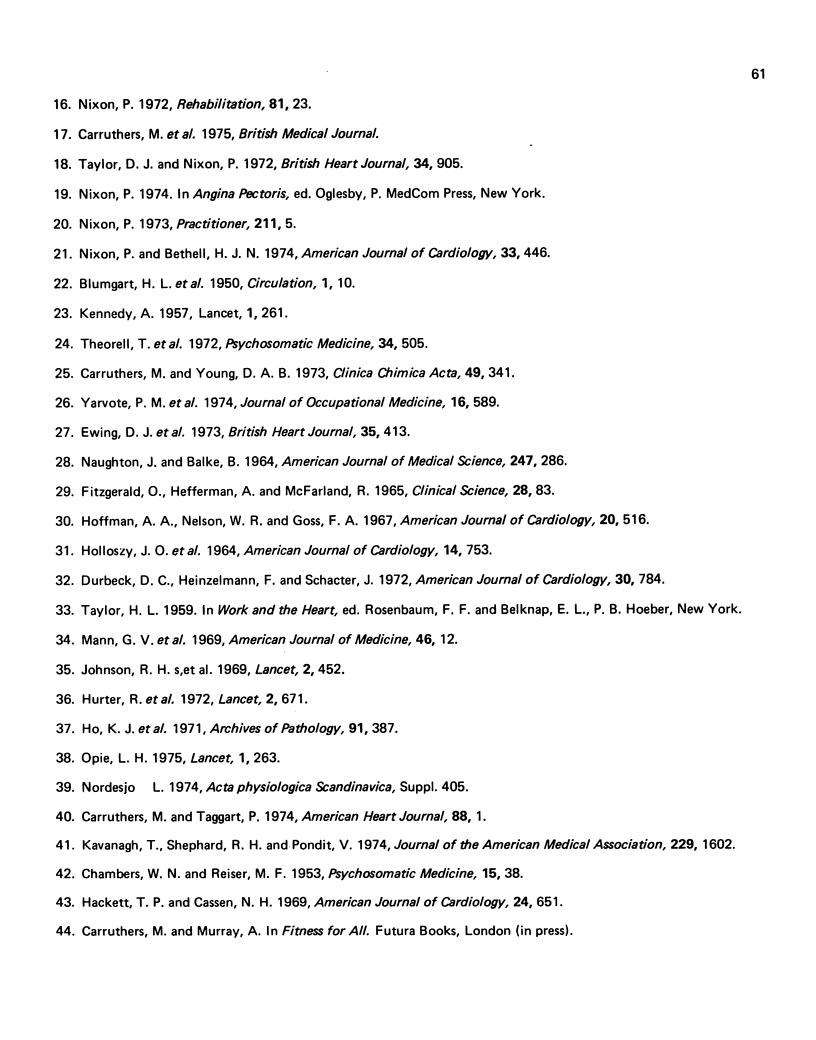
Selected References
These references are in PubMed. This may not be the complete list of references from this article.
- BLUMGART H. L., ZOLL P. M. The experimental production of intercoronary arterial anastomoses and their functional significance. Circulation. 1950 Jan;1(1):10-27, pl. doi: 10.1161/01.cir.1.1.10. [DOI] [PubMed] [Google Scholar]
- CHAMBERS W. N., REISER M. F. Emotional stress in the precipitation of congestive heart failure. Psychosom Med. 1953 Jan-Feb;15(1):38–60. doi: 10.1097/00006842-195301000-00004. [DOI] [PubMed] [Google Scholar]
- Carruthers M., Taggart P. Editorial: Paleocardiology and neocardiology. Am Heart J. 1974 Jul;88(1):1–6. doi: 10.1016/0002-8703(74)90339-1. [DOI] [PubMed] [Google Scholar]
- Carruthers M., Young D. A. Free fatty acid estimation by a semi-automated fluorimetric method. Clin Chim Acta. 1973 Dec 27;49(3):341–348. doi: 10.1016/0009-8981(73)90231-3. [DOI] [PubMed] [Google Scholar]
- Clausen J. P., Larsen O. A., Trap-Jensen J. Physical training in the management of coronary artery disease. Circulation. 1969 Aug;40(2):143–154. doi: 10.1161/01.cir.40.2.143. [DOI] [PubMed] [Google Scholar]
- Dishart M. Institutes for rehabilitation research: critical issues and recommendations. J Rehabil. 1966 Jan-Feb;32(1):38–39. [PubMed] [Google Scholar]
- Durbeck D. C., Heinzelmann F., Schacter J., Haskell W. L., Payne G. H., Moxley R. T., 3rd, Nemiroff M., Limoncelli D. D., Arnoldi L. B., Fox S. M., 3rd The National Aeronautics and Space Administration-U.S. Public Health Service Health Evaluation and Enhancement Program. Summary of results. Am J Cardiol. 1972 Nov;30(7):784–790. doi: 10.1016/0002-9149(72)90156-7. [DOI] [PubMed] [Google Scholar]
- Ewing D. J., Irving J. B., Kerr F., Kirby B. J. Static exercise in untreated systemic hypertension. Br Heart J. 1973 Apr;35(4):413–421. doi: 10.1136/hrt.35.4.413. [DOI] [PMC free article] [PubMed] [Google Scholar]
- FITZGERALD O., HEFFERNAN A., MCFARLANE R. SERUM LIPIDS AND PHYSICAL ACTIVITY IN NORMAL SUBJECTS. Clin Sci. 1965 Feb;28:83–89. [PubMed] [Google Scholar]
- Gottheiner V. Long-range strenuous sports training for cardiac reconditioning and rehabilitation. Am J Cardiol. 1968 Sep;22(3):426–435. doi: 10.1016/0002-9149(68)90126-4. [DOI] [PubMed] [Google Scholar]
- Groden B. M., Semple T., Shaw G. B. Cardiac rehabilitation in Britain (1970). Br Heart J. 1971 Sep;33(5):756–758. doi: 10.1136/hrt.33.5.756. [DOI] [PMC free article] [PubMed] [Google Scholar]
- HOLLOSZY J. O., SKINNER J. S., TORO G., CURETON T. K. EFFECTS OF A SIX MONTH PROGRAM OF ENDURANCE EXERCISE ON THE SERUM LIPIDS OF MIDDLE-AGED MAN. Am J Cardiol. 1964 Dec;14:753–760. doi: 10.1016/0002-9149(64)90004-9. [DOI] [PubMed] [Google Scholar]
- Hackett T. P., Cassem N. H. Factors contributing to delay in responding to the signs and symptoms of acute myocardial infarction. Am J Cardiol. 1969 Nov;24(5):651–658. doi: 10.1016/0002-9149(69)90452-4. [DOI] [PubMed] [Google Scholar]
- Ho K. J., Biss K., Mikkelson B., Lewis L. A., Taylor C. B. The Masai of East Africa: some unique biological characteristics. Arch Pathol. 1971 May;91(5):387–410. [PubMed] [Google Scholar]
- Hoffman A. A., Nelson W. R., Goss F. A. Effects of an exercise program on plasma lipids of senior Air Force officers. Am J Cardiol. 1967 Oct;20(4):516–524. doi: 10.1016/0002-9149(67)90029-x. [DOI] [PubMed] [Google Scholar]
- Hurter R., Peyman M. A., Swale J., Barnett C. W. Some immediate and long-term effects of exercise on the plasma-lipids. Lancet. 1972 Sep 30;2(7779):671–674. [PubMed] [Google Scholar]
- KENNEDY A. Individual reactions to change as seen in senior management in industry. Lancet. 1957 Feb 2;272(6962):261–263. doi: 10.1016/s0140-6736(57)90317-3. [DOI] [PubMed] [Google Scholar]
- Kavanagh T., Shephard R. H., Pandit V. Marathon running after myocardial infarction. JAMA. 1974 Sep 16;229(12):1602–1605. [PubMed] [Google Scholar]
- Mann G. V., Garrett H. L., Farhi A., Murray H., Billings F. T. Exercise to prevent coronary heart disease. An experimental study of the effects of training on risk factors for coronary disease in men. Am J Med. 1969 Jan;46(1):12–27. doi: 10.1016/0002-9343(69)90054-0. [DOI] [PubMed] [Google Scholar]
- NAUGHTON J., BALKE B. PHYSICAL WORKING CAPACITY IN MEDICAL PERSONNEL AND THE RESPONSE OF SERUM CHOLESTEROL TO ACUTE EXERCISE AND TO TRAINING. Am J Med Sci. 1964 Mar;247:286–292. doi: 10.1097/00000441-196403000-00007. [DOI] [PubMed] [Google Scholar]
- Naughton J., Bruhn J., Lategola M. T., Whitsett T. Rehabilitation following myocardial infarction. Am J Med. 1969 May;46(5):725–734. doi: 10.1016/0002-9343(69)90023-0. [DOI] [PubMed] [Google Scholar]
- Nixon P. G., Bethell H. J. Preinfarction ill health. Am J Cardiol. 1974 Mar;33(3):446–449. doi: 10.1016/0002-9149(74)90331-2. [DOI] [PubMed] [Google Scholar]
- Nixon P. G. Coronary heart disease and its emergencies. Practitioner. 1973 Jul;211(261):5–16. [PubMed] [Google Scholar]
- Nixon P. The prevention of unnecessary death from coronary heart disease. Health Visit. 1970 Nov;43(11):356–357. [PubMed] [Google Scholar]
- Opie L. H. Sudden death and sport. Lancet. 1975 Feb 1;1(7901):263–266. doi: 10.1016/s0140-6736(75)91155-1. [DOI] [PubMed] [Google Scholar]
- Taylor D. J., Nixon P. G. Assessment of left ventricular function after myocardial infarction. Br Heart J. 1972 Sep;34(9):905–910. doi: 10.1136/hrt.34.9.905. [DOI] [PMC free article] [PubMed] [Google Scholar]
- Theorell T., Lind E., Fröberg J., Karlsson C. G., Levi L. A longitudinal study of 21 subjects with coronary heart disease: life changes, catecholamine excretion and related biochemical reactions. Psychosom Med. 1972 Nov-Dec;34(6):505–516. doi: 10.1097/00006842-197211000-00003. [DOI] [PubMed] [Google Scholar]
- Yarvote P. M., McDonagh T. J., Goldman M. E., Zuckerman J. Organization and evaluation of a physical fitness program in industry. J Occup Med. 1974 Sep;16(9):589–598. doi: 10.1097/00043764-197409000-00003. [DOI] [PubMed] [Google Scholar]


